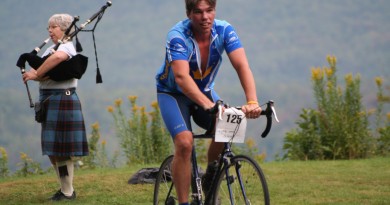Building your Baseline, Trimming your Waistline — Using the Winter Wisely
Posted December 18th, 2010
If you’re like me, you could be coming off the holiday season with a few extra pounds and a bunch of missed workouts. However, in your haste to remedy the weight issue you should literally slow down and consider the following few points.
First, while you might be concerned about body weight, doing the correct type of base training for this time of year will more appropriately address this issue.
Second, this time of year should be all about base-building or developing your aerobic foundation.
Third, in order to do this you must pick the correct low level of intensity.
Finally, not only will the correct low level of intensity help build your aerobic base, it will also help with the fat burning and weight control.
Consider the following physiology:
For simplicity sake, let’s assume that the body burns two types of substrates; carbohydrate and fat (we know that protein is also a factor, as is alcohol, especially at this time of year). At all times the body burns some combination of these two and never exclusively one or the other. We could further simplify the thought process by defining fat use as aerobic exercise and carbohydrate use as anaerobic exercise (even though both contribute). In other words, as the intensity of exercise increases the amount of fat we burn decreases and the amount of carbohydrate we burn increases. So, to maximize our fat burning, we want long and slow, and longer is better. Now for a little more physiology:
Assume we have two basic fiber types in our skeletal muscle: fast twitch and slow twitch. Both have different recruitment patters that vary as a function of exercise intensity. Fast twitch fibers are more recruited at higher intensities and slow twitch more at slower intensities. Fast twitch are larger than slow twitch and smaller fibers are always recruited first. We call this the size principle. As the intensity increases and more force is needed, more fast twitch fibers are recruited. Now, as force output increases or speed increases, etc., you breathe more heavily as at the same time you need to produce more energy. In other words, we start to use more anaerobic energy or carbohydrates. So, the pattern goes like this – increase the intensity, increase the fast twitch recruitment; increase the fast twitch recruitment, increase anaerobic metabolism; increase anaerobic metabolism, increase carbohydrate usage and decrease fat usage. So bottom line is in order to burn fat we need to exercise slower.
Consider this: If you exercised at 85 to 90 percent of max for 30 to 40 minutes you would burn mostly carbohydrates. That’s why carbohydrate replenishment becomes such an important issue in race situations as the intensity is higher. Since we replenish our carbohydrates almost on a daily basis, high-intensity exercise often causes very little fat weight loss. This is why many people exercise hard and yet do not lose weight and may, in fact, gain weight.
Here are some more points to consider: The substrate that is burned is pretty much a function of the oxygen that is available. So the overall state of our cardiovascular system plays a large role in our fuel economy. Increased aerobic fitness means increased fat burning. Therefore, we want to spend appropriate amounts of time developing our cardiovascular system at the right intensity. There are many reasons why elite endurance athletes are thin, one being that they have become very efficient at burning fat. Some other factors do need to be considered in order to apply this logic.
1. It takes 12 to 16 weeks to develop and deposit new blood vessels.
2. The stimulus for deposition of blood vessels is consistent aerobic stimulus lasting 40+ minutes 4 to 5 times a week. For elite athletes, very long sessions are often needed. For example, more than 90-120 minutes if you’re a runner and more than 4 hours if a cyclist.
3. The intensity must be such that it taxes predominantly the aerobic system and not the anaerobic system.
4. The process takes time and patience.
In other words, aerobic base-building and weight control requires long (boring in the winter) periods of low-level, steady-state exercise, and the off-season is perfect for it.
Now, the key point here is to use the winter wisely and use the absence of competition to focus on gradually increasing your volume of low-intensity work and lay the foundation for the higher-intensity work to follow.
TWO MORE CONCEPTS
A final point I’d like to introduce is the concept of duration of exercise and a concept called oxygen deficit. Anytime we change our metabolic intensity, e.g., at the beginning of exercise or changing the intensity during exercise, you’ll notice a short period of discomfort or heavier breathing. The reason for this is that we have briefly moved from a dependence on aerobic metabolism to a greater dependence on anaerobic metabolism.
After a few minutes the respiratory and cardiovascular systems will catch up (reach steady state) and this brief shortage of oxygen will be corrected. This period of oxygen shortage is called the oxygen deficit, and it occurs at the beginning of exercise and with any rapid changes in intensity.
So what does all this mean? Well, when we start exercise we experience an oxygen deficit that increases our dependence on anaerobic metabolism and carbohydrates, that’s why it’s often uncomfortable. This is actually the root cause of the old “I started too fast syndrome” in that we dramatically increased our reliance on anaerobic metabolism, increased our production of the dreaded lactic acid, and then couldn’t deal with it.
Good news is that after 10 to 15 minutes, things will settle down, and if the intensity is low enough our dependence will gradually lean more towards fat burning and the lactic acid production rates will decline and things become more confortable. However, even with this adjustment, it often takes about 30 minutes until we are actually using more fat than carbohydrates. This is why we must exercise at least 30-40 minutes steadily for weight control. So, as you can see, we can kill two birds with one stone by methodically designing our off-season program to focus on base building and being patient. Bon Voyage!
Declan Connolly is a professor of exercise physiology and kinesiology at the University of Vermont, a fellow of the American College of Sports Medicine, a certified strength and conditioning specialist, past president of the New England American College of Sports Medicine, and consultant to the NHL, NFL, and IOC. For more information, training tips, and articles by Dr. Connolly, go to www.vermontfit.com.


